Bobbin driver
Throughout history, lockstitch sewing machines have used a variety of methods to drive their bobbins so as to create the lockstitch.
| Names | Invented | Description | Picture | Notes |
|---|---|---|---|---|
| Transverse shuttle Longitudinal shuttle |
1846 by Elias Howe[1]
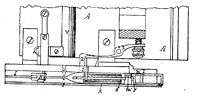 Figure 5 from Howe's patent 4750, showing transverse shuttle 'K' in its race |
Transverse shuttles carry the bobbin in a boat-shaped shuttle, and reciprocate the shuttle along a straight horizontal shaft. The design was popularized in Singer's 'New Family' machine.[2] The design became obsolete once the other bobbin driver designs were developed.[3] |  Shuttle from a transverse shuttle bobbin driver |
Sometimes incorrectly called an "oscillating shuttle". |
| Vibrating shuttle | 1850 by Allen B. Wilson[4]
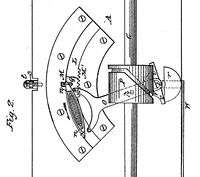 Figure 2 from Wilson's patent 7776, showing vibrating shuttle |
Vibrating shuttle machines carry their bobbin in a bullet-shaped shuttle, and reciprocate their shuttle through a short arc. The design was popularized in the White Sewing Machine Company's 'White Sewing Machine' and Singer's 27-series machines.[5] Now obsolete.[6] |  Shuttle from a vibrating shuttle bobbin driver |
Main article: Vibrating shuttle |
| Rotary hook Rotating hook |
1851 by Allen B. Wilson[8]
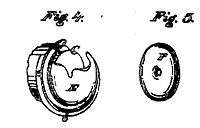 Figures from Wilson's patent 9041, showing rotary hook and bobbin |
Rotary hook machines hold their bobbin stationary, and continuously rotate the thread hook around it. The design was popularized in the White Sewing Machine Company's 'Family Rotary' sewing machine[9] and Singer's models 95 and 115.[10] | 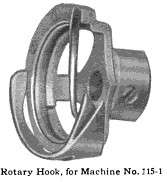 Hook from a rotary hook bobbin driver |
Main article: Rotary hook |
| Oscillating shuttle | 1877 by Lebbeus B. Miller and Phillip Diehl[11]
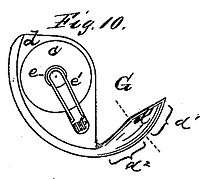 Figure 10 from Miller/Diehl patent 208838, showing oscillating shuttle |
Oscillating shuttle machines mount their bobbin on the hook, and reciprocate the hook through a short arc. The design was popularized in Singer's models 15 'Improved Family' and 31.[12] | 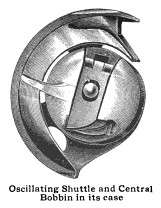 Shuttle and bobbin from an oscillating shuttle bobbin driver |
|
| Oscillating hook | ? | Oscillating hook machines hold their bobbin stationary, and reciprocate the hook through a short arc. The bobbin lays horizontally, right under the needle plate. The design was popularized in Singer's model 66.[13] | 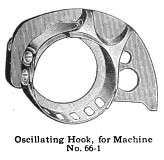 Hook from an oscillating hook bobbin driver |
"Rotating shuttle"
The term rotating shuttle is ambiguous. Sometimes it refers to a bobbin case,[14] and sometimes it refers to a rotary hook design.[15]
References
- ↑ US patent 4750, published 10 September 1846
- ↑ Singer Sewing Machine Company (1914). "Monograph 5". Mechanics of the Sewing Machine. p. 49.
- ↑ Grace Cooper (2004). "1913 trade flyer offering a treadle cabinet and a choice of machines representing every bobbin driver design except the transverse shuttle". The Sewing Machine: Its Invention and Use. Smithsonian Museum. p. 152.
- ↑ Refer to Vibrating shuttle for full inventor credits with references
- ↑ All information drawn from the Vibrating shuttle article
- ↑ Singer's last vibrating shuttle machine was built in 1962, according to the references on the Singer Model 27 and 127 page
- ↑ See e.g. US patent 5617803, "Rotary Loop Taker with Replaceable Tip", issued 1997
- ↑ US patent 9041, published 15 June 1852; but see Rotary hook for full inventor credits with references
- ↑ All information drawn from the Rotary hook article
- ↑ Singer Sewing Machine Company (1914). "Monograph 5". Mechanics of the Sewing Machine. pp. 54–55.
- ↑ US patent 208838, issued 8 Oct 1878; and refinement US patent 221338, issued 4 November 1879. The Singer Sewing Machine Company (1914). "Monograph 5". Mechanics of the Sewing Machine. p. 50., the date of invention is given as 1879, but the Miller/Diehl patent trail actually began in 1877.
- ↑ Singer Sewing Machine Company (1914). "Monograph 5". Mechanics of the Sewing Machine. p. 52.
- ↑ Singer Sewing Machine Company (1914). "Monograph 5". Mechanics of the Sewing Machine. p. 53.
- ↑ See e.g. US patent 3921553, "Lock Stitch Rotating Shuttle", issued 1975, or US patent 3698333, "Rotating Shuttle Drive Mechanisms", issued 1972
- ↑ See e.g. US patent 36256, "Sewing Machine" (ironically filed by Wheeler & Wilson), or US patent 2257950, "Sewing Machine", issued 1941
This article is issued from Wikipedia - version of the 11/14/2016. The text is available under the Creative Commons Attribution/Share Alike but additional terms may apply for the media files.